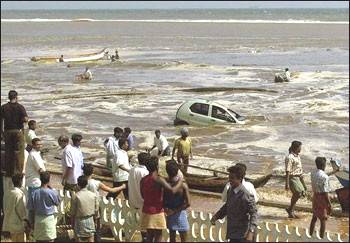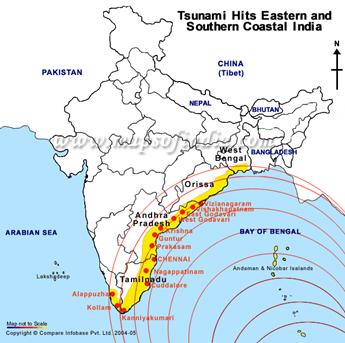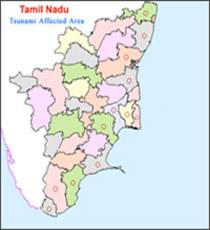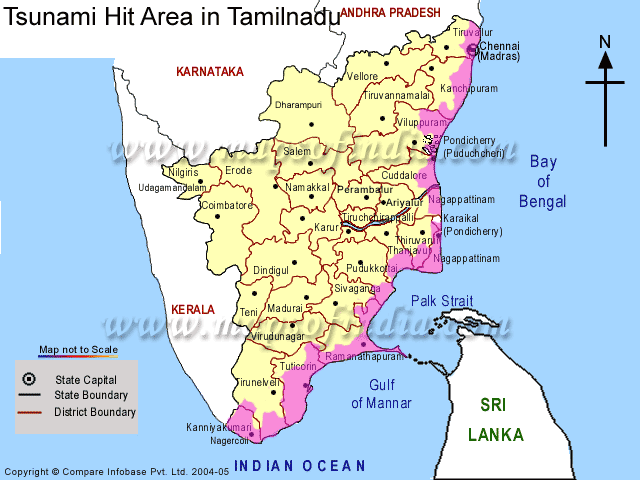|
A system of gravity waves formed in the sea due to large scale disturbance of sea level over a short duration of time.
- Tsunamis are caused by earthquakes under the sea bottom, submarine volcanic eruptions, displacement of submarine sediments, coastal landslides and meteor impact. However, not all coastal earthquakes produce Tsunamis.
- A tsunami (pronounced su-nah-me) is a wave train, or series of waves, generated in a body of water by an impulsive disturbance that vertically displaces the water column.
- Earthquakes, landslides, volcanic eruptions, explosions, and even the impact of cosmic bodies, such as meteorites, can generate tsunamis.
- Tsunamis can savagely attack coastlines, causing devastating property damage and loss of life.

What does "tsunami" mean?
Tsunami is a Japanese word with the English translation, "harbor wave." Represented by two characters, the top character, "tsu," means harbor, while the bottom character, "nami," means "wave."
In the past, tsunamis were sometimes referred to as "tidal waves" by the general public, and as "seismic sea waves" by the scientific community. The term "tidal wave" is a misnomer; although a tsunami's impact upon a coastline is dependent upon the tidal level at the time a tsunami strikes, tsunamis are unrelated to the tides. Tides result from the imbalanced, extraterrestrial, gravitational influences of the moon, sun, and planets.
The term "seismic sea wave" is also misleading. "Seismic" implies an earthquake-related generation mechanism, but a tsunami can also be caused by a non-seismic event, such as a landslide or meteorite impact.

Learning to cope with disasters:
What can we do now:
- Disaster Management Information System must be built in every district of the country linked with each other, available on the web and also in public libraries. We should know where are the inventories available of critical equipments, skills, resources and information and how can one access them on voluntary or payment basis. The database of various services and infrastructure in private, public and voluntary sectors should be updated regularly. Every college should take responsibility for collecting and updating information about certain categories of services or equipments. Simple information such as about ham radio operators can be put on the web without fail.
- Just as we have national services scheme, we must now think of national disaster management volunteers who would receive training and be empowered to organize themselves as effective teams for helping local communities around them. No amount of state help can substitute for community based structures for self help. Supreme Court had passed judgments and given advice for starting courses on disaster management in various educational institutions. Have we ever monitored how many such courses exist and what quality of preparedness has been achieved?
- The major tragedy will begin when the media will get interested in new issues, fight among some other politicians or corporate games. Resources would be required for repairing and building the primary school buildings, primary health centres, livestock, clinics, tree climbing devices for palm workers, herbal and other medicines, mat making machines, and machines which can use materials from damaged trees and bio waste, old bamboo scrap, processing machine for various edible and non-edible oilseeds, etc. A proper rehabilitation plan will have to be built for each village affected by the disaster with proper accountability structure. The accounts of every investment must be made public and people should be able to know how much funds were mobilized by which NGO or government agency and how were they used for the purpose.
- In cases where fishing communities or island based indigenous / tribal communities have been affected very severely, long term rehabilitation plans have to be initiated. These plans must learn from the mistakes made in earlier rehabilitation projects.
- There is very important need to document the experience of the damage caused and ensuing suffering along with the coping strategies of local communities and administration. Some novel lessons would emerge.
- One of the major problems in relief is that what is needed where is often not known to the people who want to provide support. The result is that lot of materials get wasted or misdirected. We need to put a spreadsheet immediately on the web pointing out village wise needs, contact persons’ names and addresses so that civil society efforts can be targeted more efficiently. We had tried to put an inventory management system in place after Gujarat earthquake with the help of our students and faculty. The students had stacked the relief material received from all over the country in Kutchh and given assorted sheets to the Relief Commissioner. Where we failed was to link this system with GIS so that one could track the deliveries, collect the response and also avoid pilferages. It will be useful if some of the IT firms in Chennai would volunteer to create such a GIS so that people can update the demand and supply information and every unit of material is optimally utilized.
- The psychological rehabilitation is no less important. The children affected the by the shock and tragedy are particularly vulnerable. The arrangements for adoption of orphan children with proper community care have to be put in place.
- It is very disheartening to hear that in large number of cases of dead people, the Public Health authorities have been reportedly hesitant in maintaining proper records. It might save the state and central governments some money from the compensation fund but it would certainly inflict damage on the social conscience of the society. If the rehabilitation funds reach late, they are as good as not given. Unless central government ensures delivery of compensation through community control systems within next 24 hours, the fairness in the system will become more and more difficult to achieve with every passing day. While we still need immediate help, the long term rehabilitation must be simultaneously planned.
Tsunami Prone and Affected Districts of Tamil Nadu
 |
| Chennai |
Tiruvallur |
| Cuddalore |
Villupuram |
| Kancheepuram |
Nagapattinam |
| Thanjavur |
Pudukottai |
| Thiruvarur |
Ramanathapuram |
| Thoothukudi |
Tirunelveli |
| Kanyakumari |
|
|

Source: http://www.tn.gov.in/tsunami/affected.html#
|




